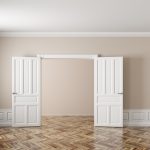Or course painting can make a house look much better, changing the feel of a home, ensuring that the furnishings and décor match the wall colour. However, this can be ruined if we don’t get the painting right. Achieving a professional-quality paint finish requires more than just a brush and a can of paint. Many homeowners attempt to tackle painting projects themselves, only to encounter a series of common mistakes that can lead to disappointing results. It helps to explore these common mistakes and learn how to avoid them. If you’re searching for “house painters near me” to ensure a flawless job, this guide will help you understand what to look out for.
Skipping Surface Preparation
One of the most critical steps in painting is proper surface preparation. Many DIY painters underestimate the importance of this step. The old adage that preparation is half the job is not far from the truth. Painting over dirty, greasy, or uneven surfaces can prevent the paint from adhering properly, leading to peeling and flaking.
Solution: Clean the walls thoroughly, sand any rough spots, and fill in holes or cracks with spackle. Allow the filler to dry completely and sand it smooth before applying primer.
Not Using Primer
Primer is essential for good-looking paintwork. Yet many people skip this step to save time and money. Primer helps the paint adhere better and provides a uniform base, especially on new drywall or over dark colours. This prevents any uneven colour on the underlying surface showing through the final paint. Some people use a paint that combines primer and the final coat, but these tend to be pricey. If is usually better, and less expensive, to use separate primers and final coat.
Solution: Always use a primer appropriate for the surface you are painting. For previously painted surfaces, a bonding primer may be necessary. For new drywall, use a drywall primer. Primers are also crucial when painting over stains or marks that might bleed through the topcoat.
Choosing the Wrong Paint
Selecting the right type of paint is crucial. Different surfaces and rooms require specific types of paint. For example, high-gloss paint is durable and easy to clean, making it ideal for kitchens and bathrooms, while flat paint hides imperfections better, making it suitable for ceilings and low-traffic areas.
Solution: Consult with a professional or a knowledgeable sales associate at your local paint store to choose the right paint for each surface and room. Consider factors like durability, ease of cleaning, and the finish you desire. Eggshell paint is a good choice in almost all situations, being both easy to clean and forgiving of surface imperfections and lighting conditions.
Ignoring the Weather
The weather can significantly affect the outcome of your paint job. Painting in extremely hot, cold, or humid conditions can cause the paint to dry too quickly or not adhere properly.
Solution: Check the weather forecast and plan your painting project for a day with mild, dry weather. Avoid painting in direct sunlight or during high humidity, as these conditions can lead to paint blistering and poor adhesion. Interior painting might benefit from a dehumidifier.
Using Poor-Quality Tools
The quality of your brushes, rollers, and other tools can make a significant difference in the final result. Cheap brushes can leave bristles in the paint, and low-quality rollers can result in an uneven finish.
Solution: Invest in high-quality brushes and rollers suitable for the type of paint you are using. Quality tools provide better coverage and a smoother finish, making the job easier and more efficient.
Overloading the Brush or Roller
Applying too much paint at once can lead to drips, runs, and an uneven finish. It’s a common mistake to overload the brush or roller in an attempt to cover the surface more quickly.
Solution: Dip your brush or roller into the paint lightly and apply it in thin, even coats. It’s better to apply multiple thin coats than one thick coat. This method ensures better coverage and a smoother finish.
Failing to Use Painter’s Tape
Cutting in around edges, trim, and other obstacles without using painter’s tape can result in uneven lines and a messy finish. Many DIY painters skip this step to save time, but it often leads to more time spent on touch-ups.
Solution: Use high-quality painter’s tape to mask off edges, trim, and other areas you don’t want to be painted. Press the tape down firmly to prevent paint from seeping underneath. Remove the tape while the paint is still slightly wet to avoid peeling.
Not Allowing Enough Drying Time
Rushing through the painting process without allowing each coat to dry properly can lead to a tacky, uneven finish. It’s important to follow the manufacturer’s recommendations for drying times between coats.
Solution: Be patient and allow each coat of paint to dry thoroughly before applying the next one. Factors like temperature and humidity can affect drying times, so adjust accordingly.
Neglecting Safety Precautions
Painting can involve exposure to fumes, heights, and potentially hazardous materials. Failing to take proper safety precautions can lead to accidents and health issues.
Solution: Use appropriate personal protective equipment (PPE) such as masks, gloves, and goggles. Ensure good ventilation when painting indoors. If working on a ladder, make sure it is stable and positioned correctly.
Inconsistent Paint Mixing
If you are using multiple cans of paint, inconsistencies in colour can occur if the paint is not mixed thoroughly. This can result in noticeable differences in colour on the walls.
Solution: Mix all the paint cans together in a large bucket to ensure colour consistency. This process is called “boxing” the paint and helps to achieve a uniform colour throughout the project.
Conclusion
Avoiding these common mistakes can make a significant difference in the quality and longevity of your paint job. If you find yourself overwhelmed by the process or unsure of how to achieve the best results, consider searching for “house painters near me.” Professional painters have the experience, tools, and expertise to deliver a flawless finish that enhances the beauty and value of your home. Whether you decide to DIY or hire professionals, understanding these pitfalls will help you make informed decisions and achieve the best possible outcome.






